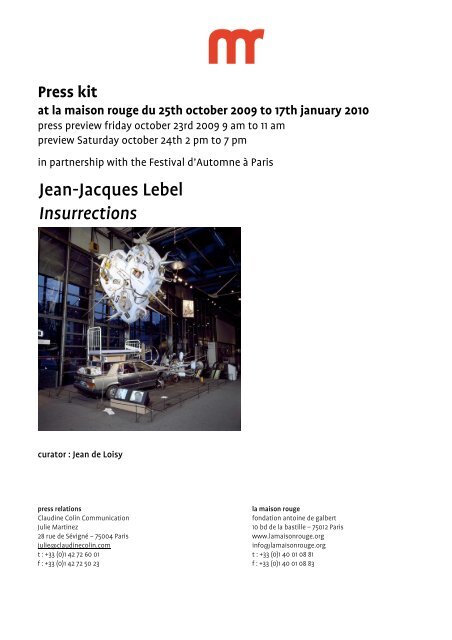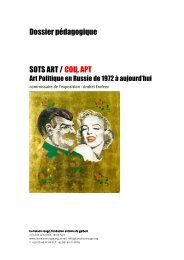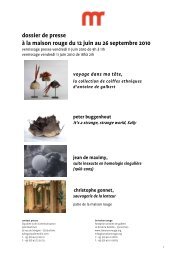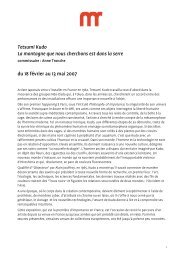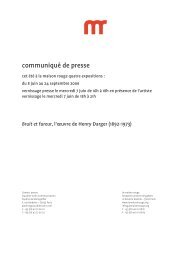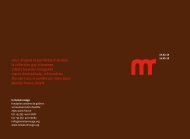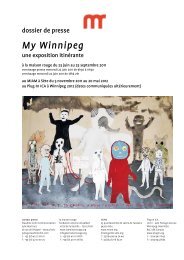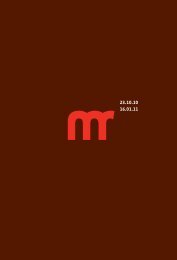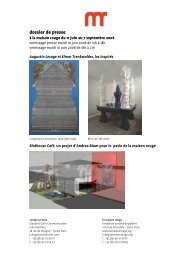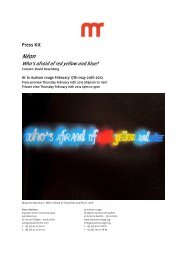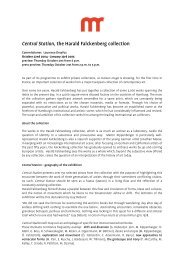Press kit JJL relu - La maison rouge
Press kit JJL relu - La maison rouge
Press kit JJL relu - La maison rouge
Create successful ePaper yourself
Turn your PDF publications into a flip-book with our unique Google optimized e-Paper software.
<strong>Press</strong> <strong>kit</strong><br />
at la <strong>maison</strong> <strong>rouge</strong> du 25th october 2009 to 17th january 2010<br />
press preview friday october 23rd 2009 9 am to 11 am<br />
preview Saturday october 24th 2 pm to 7 pm<br />
in partnership with the Festival d’Automne à Paris<br />
Jean-Jacques Lebel<br />
Insurrections<br />
curator : Jean de Loisy<br />
press relations<br />
la <strong>maison</strong> <strong>rouge</strong><br />
Claudine Colin Communication<br />
fondation antoine de galbert<br />
Julie Martinez<br />
10 bd de la bastille – 75012 Paris<br />
28 rue de Sévigné – 75004 Paris www.la<strong>maison</strong><strong>rouge</strong>.org<br />
julie@claudinecolin.com<br />
info@la<strong>maison</strong><strong>rouge</strong>.org<br />
t : +33 (0)1 42 72 60 01 t : +33 (0)1 40 01 08 81<br />
f : +33 (0)1 42 72 50 23 f : +33 (0)1 40 01 08 83
contents<br />
la <strong>maison</strong> <strong>rouge</strong><br />
p.3 presentation<br />
la <strong>maison</strong> <strong>rouge</strong>, Antoine de Galbert, building,<br />
the boosktore, the restaurant, les amis de la <strong>maison</strong> <strong>rouge</strong><br />
p.4 activities at la <strong>maison</strong> <strong>rouge</strong><br />
the vestibule, the suite, for children, guided tours<br />
Jean-Jacques Lebel<br />
Soulèvements<br />
p.6 press release<br />
p.7 the exhibition<br />
p.8 artists<br />
p.9 biography of Jean-Jacques Lebel<br />
p.13 Jean-Jacques Lebel, Art as Upheavel !<br />
interview conducted by Jean de Loisy<br />
p.16 the catalogue<br />
p.17 around the exhibition : Polyphonix at CENTQUATRE<br />
p.18 pictures<br />
p.23 the vestibule<br />
p.24 Hospitalities 2009<br />
p.25 pratical information<br />
supports<br />
cover :<br />
Jean-Jacques Lebel, Monument à Félix Guattari, vue de l’exposition Hors Limites, L’art et la vie 1952-1994,<br />
Centre G. Pompidou, MNAM, Paris, 1994 © DR<br />
2
presentation<br />
la <strong>maison</strong> <strong>rouge</strong>, a private, non-profit foundation, opened in June 2004 in Paris. Its purpose is to promote<br />
contemporary creation through a programme of three solo or thematic temporary exhibitions a year,<br />
certain of which are staged by independent curators.<br />
<strong>La</strong> <strong>maison</strong> <strong>rouge</strong> was created on the initiative of Antoine de Galbert, an art collector and active figure on<br />
the French art scene. While Antoine de Galbert's own collection is not shown, the entire project is<br />
fashioned by his personality and outlook as a collector. Beginning with L’intime[Behind Closed Doors:<br />
the private life of collections], la <strong>maison</strong> <strong>rouge</strong> stages exhibitions on the theme of private collections and<br />
the issues and questions surrounding them.<br />
Antoine de Galbert, born in 1955 and a graduate in political science, Antoine de Galbert worked in<br />
corporate management before opening a contemporary art gallery in Grenoble for some ten years.<br />
Concurrently, he purchased the first works in a collection that was to take on growing importance in his<br />
life. In 2000 he chose to create a foundation as a means of both anchoring his commitment to<br />
contemporary creation and opening his collection to the public.<br />
le bâtiment <strong>La</strong> <strong>maison</strong> <strong>rouge</strong> is installed in a renovated factory in the Bastille district of Paris,<br />
overlooking the Arsenal marina. The 2,500 sqare meters site, including 1,300 square meters of exhibition<br />
space, is centred around "la <strong>maison</strong> <strong>rouge</strong>" or red house.<br />
By naming the venue after this house, la <strong>maison</strong> <strong>rouge</strong> makes clear its vocation as a welcoming, convivial<br />
space where visitors can see exhibitions, attend lectures, enjoy a drink or explore the bookstore.<br />
The artist Jean-Michel Alberola (born in Paris in 1953) was commissioned for the interior design of the<br />
reception areas.<br />
la librairie la <strong>maison</strong> <strong>rouge</strong> has chosen Bookstorming, a specialist in contemporary art publications, for<br />
its bookstore at 10 bis, boulevard de la Bastille. Its selection of titles is regularly updated to reflect the<br />
current exhibitions at la <strong>maison</strong> <strong>rouge</strong>. It also stocks art DVDs and videos, publications on the latest<br />
developments in the contemporary art world, and proposes an important catalogue of out-of-print books<br />
and books by artists.<br />
le restaurant The restaurant's new chef, Pascal Owczarek, proposes creative cuisine that is a fusion of<br />
classic dishes and world food. Open Tuesday from noon to 3pm and Wednesday to Sunday at the<br />
foundation's usual times. Brunch on Sunday. The menu changes with each exhibition.<br />
les amis de la <strong>maison</strong> <strong>rouge</strong> A non-profit organisation, les amis de la <strong>maison</strong> <strong>rouge</strong> is closely<br />
involved with and supports Antoine de Galbert's project. It contributes to reflection and debates on the<br />
theme of the private collection, organises activities to coincide with the exhibitions, and promotes la<br />
<strong>maison</strong> <strong>rouge</strong> among French and international audiences.<br />
Membership from €70<br />
t. +33 (0)1 40 01 94 38, amis@la<strong>maison</strong><strong>rouge</strong>.org<br />
3
activities at la <strong>maison</strong> <strong>rouge</strong><br />
the vestibule<br />
Always attentive and open to creations by young artists, Antoine de Galbert created this openaccess<br />
space in 2006, showing new exhibitions every four to six weeks.<br />
the suite<br />
la <strong>maison</strong> <strong>rouge</strong> develops other activities alongside its exhibitions, and in collaboration with<br />
Gérard Wacjman has opened a hotel room, the Suite, inside its walls. It welcomes guests from all<br />
fields of thought and contemporary creation to provoke unexpected encounters with the public.<br />
Following on from la suite, le son et l'écrit, for which literary critic Aurélie Djian proposed listening<br />
sessions built around reading and the written word, Sophie Delpeux* invites us to les racontars de<br />
performance.<br />
One Thursday a month, within the intimate setting of <strong>La</strong> Suite, two guests will tell the same story, each<br />
colouring it with their own experiences and concerns.<br />
Artists, choreographers, writers, historians and philosophers will take turns to create a live and living<br />
performance, restoring the power of the narrative to spark listeners' imagination.<br />
*Sophie Delpeux is an art historian and associate professor at the University of Paris Panthéon-Sorbonne.<br />
She has a particular interest in performance and its history. Sophie Delpeux has published articles on Valie<br />
Export, Otto Mühl, Dennis Oppenheim and Gina Pane, among others. She is currently writing an article on<br />
Chris Burden, and a monograph on Allan Kaprow.<br />
4
for children<br />
le mercredi, on goûte aux contes<br />
One Wednesday a month, a story-teller takes children aged from 4 to 11 on a journey into the<br />
land of imagination.<br />
Story + snack: €7 for children and accompanying adults.<br />
<strong>La</strong>sts around 90 minutes<br />
next storytimes :<br />
18th november at 3 pm<br />
16th december at 3 pm<br />
6th january at 3 pm<br />
Information and reservations : stephaniemolinard@la<strong>maison</strong><strong>rouge</strong>.org<br />
guided tours<br />
for individuals<br />
Free guided tour in French of the exhibitions every Saturday and Sunday at 4 pm.<br />
for groups<br />
guided tours in french :€75<br />
Visits are assured by students in history of art, specialized in contemporary art.<br />
informations et reservations: Stéphanie Molinard, 01.40.01.92.79 ou<br />
stephaniemolinard@la<strong>maison</strong><strong>rouge</strong>.org<br />
><br />
The full programme and dates for activities are at www.la<strong>maison</strong><strong>rouge</strong>.org<br />
5
Jean-Jacques Lebel<br />
Insurrections<br />
curator: Jean de Loisy<br />
with Sandra Adam-Couralet<br />
As a foundation set up by the contemporary art collector Antoine de Galbert, la <strong>maison</strong> <strong>rouge</strong> looks with<br />
interest at private collections and the questions they raise by once a year showing works from one<br />
individual's collection. This autumn, la <strong>maison</strong> <strong>rouge</strong> turns to Jean-Jacques Lebel, a multifarious,<br />
accumulating, assembling artist and, in his own way, collector.<br />
Since 1955, Jean-Jacques Lebel has been exhibiting, writing, filming, publishing, coordinating and taking<br />
part in collective actions. First and foremost an artist, he is also an organiser of international events,<br />
exhibitions and festivals, a poet, theorist and political activist. None of the forms his life as an "inspired<br />
agitator" has taken can be dissociated from his work as an artist.<br />
This exhibition presents works born from the imaginings of this artist, conveyor and preeminent figure of<br />
avant-gardism over the past fifty years.<br />
Beyond its obvious meaning, Insurrections has other implications that span the political and the poetic,<br />
reality and its representations, reflection and the most diverse languages. In an attempt to sketch the<br />
existential portrait of this insurgent, this polysemic title encompasses Jean-Jacques Lebel's own work, that<br />
of his friends and companions, and the objects of art and combat he has gathered and which fuel his<br />
subjectivity.<br />
The exhibition is divided into themes. Each corresponds to Jean-Jacques Lebel's obsession with the<br />
enigma which a work and the wider context of its emergence raise. Happenings, Insubordination, Poetry,<br />
Hallucination, Eros, Dada, War and Rhizome are some examples. Through these interconnecting<br />
ensembles, visitors can engage with some of Jean-Jacques Lebel's major installations, works of primitive<br />
art, works by anonymous artists and others by such important allies as Johan Heinrich Füssli, Giuseppe<br />
Arcimboldo, Louise Michel, Fourier, Ravachol, Guillaume Apollinaire, Marcel Duchamp, Pablo Picasso, Otto<br />
Dix, André Breton, Francis Picabia, Antonin Artaud, Bernard Heidsieck, Erró, Antonio Saura, Konrad<br />
Klapheck, Öyvind Fahlström, Peter Saul, Camilla Adami and Orlan: some three hundred works in all which<br />
continue to engross the artist in an earnest and endless dialogue.<br />
Insurrections celebrates the radical subjectivity of an uncommon individual. It focuses on the intense and<br />
continuous exchanges that take place between art and life, research and mediation, self and tribe. Notions<br />
of discipline and classification cannot contain the work of Jean-Jacques Lebel. His is a mind in action,<br />
fuelled by the thoughts and creations of every era and civilisation, undeterred by boundaries and<br />
conventions.<br />
6
The exhibition<br />
"Insurrections is simultaneously a historical, mental, private and social process that implies an extended period of<br />
time and a spirit of permanent rebellion.<br />
Our exhibition sets out to reconstruct a psychic mood made up of all sorts of activities - social, artistic, political,<br />
sexual, intellectual, collective and individual - presented in the form of a barricade (knowing it cannot be other than<br />
transient). It is an attempt to create a montrage of something that is merely passing through.<br />
We take the visitor on a journey that fully integrates the untamed side of our lives, what Lou Reed called "a walk on<br />
the wild side." This is pure thought, untrammelled by ideological presuppositions. This is what distinguishes a<br />
miscellany from a collection: you never know what you'll end up with. It's a kind of visual anthropology." Jean-<br />
Jacques Lebel, June 2009.<br />
The exhibition, which comprises installations by Jean-Jacques Lebel alongside works and artefacts that are a part<br />
of his own life, reveals the depth and breadth of his personal engagements. Each of the areas in la <strong>maison</strong> <strong>rouge</strong><br />
has been given a theme that corresponds to a particular aspect of the artist's activities as an onlooker, thinker<br />
and organiser. The works thus assembled, whether created or collected, form the exhibition or montrage: a<br />
term often used by Jean-Jacques Lebel and compiled from the French words for editing a film (monter) and<br />
showing (montrer). Presented together for the first time, the assembled works and objects take us inside the<br />
mind of an artist whose multifarious œuvre is entirely devoted to exploring the poetic, political and<br />
philosophical issues addressed by art, something he has always seen as resulting from collective action and<br />
unconnected with concepts such as "author," "career" or "political correctness."<br />
entrance: the art of the barricade<br />
For Jean-Jacques Lebel, there can be no art without rebellion. The exhibition recalls the Paris Commune, Louise<br />
Michel, Charles Fourrier and Ravachol, all heralds of universal radicalism who are held up in example by Lebel.<br />
Alongside these guiding lights we find photographs of barricades - the Commune, the Liberation of Paris, May<br />
'68 – inventive, amazing, ephemeral barricades of all kinds. This remarkable collection, a kind of genealogy of<br />
subversion, is presented under a suspended installation, Hommage à André Breton. This shower of hammers<br />
and gaping women's bags tells us that the entire exhibition is a barricade. Hence the exhibition title,<br />
Insurrections.<br />
visual poetry<br />
Inasmuch as it reveals how writing and experience are inextricably linked, the writing of poetry is central to<br />
Lebel's universe. His reinterpretation of visual and sculptural works by Victor Hugo, Antonin Artaud and Francis<br />
Picabia are fundamental to his approach. Himself a poet, a translator of Ginsberg and Burroughs, and founder<br />
of the Polyphonix festival, for many years Lebel has collected paintings by the poets he admires: Baudelaire,<br />
Victor Hugo, Apollinaire, Tzara, Michaux, Artaud, Kerouac, Gysin, Gherasim Lucas and Bernard Heidsieck. His<br />
interest in drawings and paintings by writers corresponds to what he calls "laboratory zones." Experimental by<br />
definition, these are areas where the individual throws him or herself headlong into an activity without first<br />
mastering the techniques involved. The whole exhibition is coloured by poetry and poets, by their<br />
determination to "give new meaning to the words of the tribe," as Mallarmé said. Even, as Lebel himself says, to<br />
"blow up language!"<br />
Shown next to them are a group of remarkable "exquisite corpses." They introduce a more light-hearted note<br />
through a concept which Guattari described as "a collective assemblage of enunciation." Jean-Jacques Lebel is<br />
particularly drawn to the way the unpredictable "result" of these many-handed works opens up new fields of<br />
research. He himself has played the collaboration game, as shown in drawings and paintings produced with<br />
Ginsberg, Breton, Erró, Pommereule, Wilfredo <strong>La</strong>m etc., and more recently a collective picture in four<br />
interchangeable parts created with his friends Erró, Camilla Adami and Peter Saul.<br />
7
metamorphoses<br />
Faces behind masks, masks behind faces. What is it in the various "facialities" that "acts as a rhizome"? Shown<br />
side by side, Erró, Arcimboldo, Saura and an Ekoi crest mask overstep the boundaries between the mechanical<br />
and the living, man, animal, plant, past and present, the imaginable and the visible. Lebel's large video<br />
installation, Les Avatars de Vénus, is shown here on four transparent screens so that visitors can walk around<br />
inside it. The video focuses on the interminable metamorphosis of the goddess, whose successive, timeless<br />
incarnations reinvent the family tree of the icons of every culture, civilisation and era so as to reveal their<br />
unchanging essence.<br />
hallucinatory perception: "the hallucinatory experience as a laboratory for the arts of the future."<br />
(Jean-Jacques Lebel in Entretien avec Arnaud <strong>La</strong>belle-Rojoux).<br />
Here, visitors see hallucinatory perception at work. Traces of Michaux, Martini, Artaud, Leonora Carrington and<br />
Picabia, together with drawings by Jean-Jacques Lebel while under the influence of psilocybine, recount travels<br />
outside the self.<br />
Enigma<br />
Like the "unsmashable core of night" referred to by André Breton when describing his relationship with his art,<br />
enigma is the very heart of the exhibition. The difficulty in interpreting each work continues Freud's line of<br />
interrogation with respect to the human psyche. Füssli's two-way self-portrait, in the centre of this space,<br />
symbolises art's nocturnal side. The front depicts a female character, stripped bare and enucleated, a knife in<br />
her hand. The reverse shows an allegory of the artist being sculpted by his own imagination made flesh. The<br />
enigma questions our sense of privacy. Nearby, a Victor Brauner masterpiece recalls the alchemy of his unbirth,<br />
while a group of works, arranged by the artist, weave a riddle with neither beginning nor end, no way out other<br />
than to question reality, to wander aimlessly, to sink into doubt.<br />
Bordering this enigma, an installation comprises hundreds of cartridge cases, sculpted or engraved by soldiers in<br />
the trenches during the First World War, and collected and arranged by Jean-Jacques Lebel. They depict a<br />
desperate attempt to find some kind of meaning in the midst of horror. They are anonymous voices raised in<br />
protest against death at the very heart of the carnage.<br />
Dada stirs up everything<br />
"When it comes to revolt, we have no need of ancestors," said André Breton. No ancestors then. But we do need<br />
lights to show us the way through the darkness. The 1962 collage, Mon Coeur ne bat que pour Picabia, says it all.<br />
Duchamp, Baargeld, Schwitters, Tzara and, most of all, the spirit of Dadaism all make their powerful presence<br />
felt. The title itself refers back to one of the movement's most important manifestos: DADA STIRS UP<br />
EVERYTHING! The intent is clear.<br />
Rembrandt<br />
Rembrandt's small etching (1631) of a woman urinating makes him a precursor of both Duchamp (Fontaine and<br />
Étant donnés : 1) <strong>La</strong> chute d'eau, 2) le gaz d'éclairage) and Picasso (<strong>La</strong> Femme qui pisse sur la plage). Scaled up to<br />
a life-size sculpture and made into a fountain, Pisseuse de Rembrandt by Jean-Jacques Lebel is presented in the<br />
patio.<br />
Happenings<br />
In 1960 in Venice, Jean-Jacques Lebel staged Europe's first happening: L'Enterrement de la Chose. He went on to<br />
stage another twenty or so, stopping in 1968 as he felt that he had, partially at least, achieved his objective,<br />
which was to contribute to the Dadaisation of society. Through their insolence and penchant for what Levi-<br />
Strauss called "the savage mind" (la pensée sauvage), happenings such as Pour conjurer l'esprit de catastrophe,<br />
Collage, Déchirex, 120 minutes dédiées au divin marquis and Le Pseudo-Kini left their mark on the era. They are<br />
presented through films, photographs and documents.<br />
8
Journals of a wanderer<br />
All his life, Jean-Jacques Lebel has recorded his travels, interrogations, revolts, projects, love affairs,<br />
correspondences and restless wanderings in journals. Filled with drawings, paintings and writings, illustrated<br />
with images taken from current events or from the history of art and society, these raw journals, intrinsically<br />
immune to censorship, are shown for the first time ever in public at la <strong>maison</strong> <strong>rouge</strong>.<br />
Be rhizome<br />
Monument à Félix Guattari was first installed in the Centre Pompidou's Forum as part of the Hors Limites<br />
exhibition in 1994. A new version is presented here. "The idea was to make the Guattari rhizome visible and<br />
audible, as incarnated by a hundred like-minded companions, colleagues and friends of this important thinker,<br />
militant, psychoanalyst and writer who, with Gilles Deleuze, revolutionised political and philosophical thinking<br />
with Anti-Œdipus and A Thousand Plateaus, along with many other works of theory and criticism. During the<br />
exhibition, a weekly meeting, open to all, did justice to Guattari's many and various activities." (Jean-Jacques<br />
Lebel). Again, Deleuze and Guattari's rhizome concept is taken quite literally. "Artists and their works, all very<br />
different, all quite remarkable, gather in a confrontation that is beyond any constraints imposed by aesthetic or<br />
teleological considerations, in total disregard of market forces, respecting only the content and modus operandi<br />
of the individual works." (Jean-Jacques Lebel). "Visual anthropology disputes the validity of the dominant<br />
culture and the profit principle. Insurrectional art comes into its own when through it are assembled the many<br />
components, however disparate they might be, of inter-subjective thought." "The assembled works form a<br />
global movement that is without limits, without institutions, without conventions, without range and without<br />
boundaries." (Jean-Jacques Lebel).<br />
Yoko Ono, Asger Jorn, Shiraga, Jonas Mekas, Carolee Schneeman, François Dufrêne, Bernard Heidsieck, John<br />
Giorno, Tetsumi Kudo, Alain Fleischer, Jean Tinguely, Nam June Paik, Erro, Peter Saul, Jacques Monory, Frédéric<br />
Pardo, Eric Dietman, George Brecht, Esther Ferrer, Rachel <strong>La</strong>urent, Camilla Adami, Jackson McLow, Bruce Conner,<br />
William Burroughs, Allen Ginsberg and many more, all friends and associates of Jean-Jacques Lebel, give life to<br />
this rhizome.<br />
Eros, first of all the gods devised<br />
This verse from the pre-Socratic poet Parmenides set the tone for the vast Jardin d'Eros exhibition which Jean-<br />
Jacques Lebel devised and produced at Barcelona's Palau de la Virreina in 1999. Echoes of this garden are felt in<br />
this space, devoted to the eminently erotic nature of the gaze, defined as an unconscious "scopic" impulse and<br />
essential to the production, transmission and circulation of any work of art. Anything hidden or revealed by the<br />
visual arts, anything that is the object of inhibition or exhibition, sometimes both at once, needs the input of<br />
the regardeur, the looker who, according to Duchamp, "makes the painting" just as much as the painter. It is<br />
the often arduous task of looking that transforms the looker into someone who is looking, and opens up the too<br />
often censored fantastical worlds of Picasso, Grosz, Dix, Klinger, Magritte, Masson, Monory, Rachel <strong>La</strong>urent,<br />
Esther Ferrer and Rowlandson. "Obscenity has not disappeared, far from it. Rather it has moved from the sexual<br />
to the political. Power is, by definition, obscene. Political obscenity permeates events around the world, 24<br />
hours a day. So as to differentiate it from politics, sexual obscenity is labelled ignominious and placed in<br />
quarantine, in a specific place named…<br />
the unseeable: visitors will choose whether to venture there or not."<br />
Jean-Jacques Lebel's vast installation, Reliquaire pour un culte de Vénus, has been presented in more than<br />
twenty different versions over the past fifteen years, in multiple museums, arts centres and art galleries<br />
throughout Europe. Lebel started collecting the raw material for this work over 40 years ago: thousands of<br />
images, from the most noble to the most crude, from the history of art to modern <strong>kit</strong>sch, covering every era and<br />
cultural contexts. Other images have gradually been added, whether pictures donated by friends, personal<br />
photographs or news stories. The question addressed here is that of absolute beauty, the vénusté taken up by<br />
Klossowski in reference to the qualities of the goddess of love, as seen through the ages and by different<br />
civilisations. What is it that makes Beauty desirable or, on the contrary, undesirable? How do social criteria<br />
define its fluctuations and mutations?<br />
9
Artaud's Nerve Meter<br />
A homage to Antonin Artaud was staged in 2000 in Düsseldorf, entitled Man: a tree without organs. It featured<br />
an installation by Jean-Jacques Lebel that shows the ward in the Rodez psychiatric hospital where, in 1943,<br />
Artaud underwent no fewer than 52 electric shock treatments. Their violence, akin to torture, was such that they<br />
broke a vertebra in Artaud's neck. This installation, comprising electric shock apparatus of that time, a belt, a<br />
restraint bed and recordings of Artaud himself reciting his famous text, The Patients and the Doctors, can now<br />
be seen again at la <strong>maison</strong> <strong>rouge</strong>.<br />
Artists<br />
Jean-Jacques Lebel and Camilla Adami, René Alleau, Charles Amédée, Guillaume Apollinaire,<br />
Louis Aragon, Giuseppe Arcimboldo, Antonin Artaud, Hugo Ball, Johannes Theodor<br />
Baargeld, Alexandre Baudet-Dulary, Julien Blaine, Charles<br />
Baudelaire, Hans Bellmer,<br />
Ben, François Boucher, Victor Brauner, George Brecht, André Breton, Mark Brusse,<br />
William S. Burroughs, Michel Butor, Carmen Calvo, Angelo Caroselli, Leonora<br />
Carrington, William Nelson Copley, Aloïse Corbaz, Gregory Corso, Dali, André Derain,<br />
Eric Dietman, Otto Dix, Jean Dubuffet, Marcel Duchamp, François Dufrêne, Erró, Robert<br />
Filliou, Alain Fleischer, Gala, Allen Ginsberg, John Giorno, Georges Grosz, Brion Gysin,<br />
Blalla W. Hallmann, Al Hansen, Raymond Hains, Bernard Heidsieck, Valentine Hugo,<br />
Victor Hugo, Asger Jorn, Allan Kaprow, Jack Kerouac, Max Klinger, Pierre Klossowski,<br />
Max Klinger, Alfred Kubin, Kudo Tetsumi,<br />
Arnaud <strong>La</strong>belle-Rojoux, Wilfredo <strong>La</strong>m,<br />
Jacqueline <strong>La</strong>mba, Mikhail <strong>La</strong>rionov, Marie <strong>La</strong>urencin, Augustin Lesage, Jackson Mac<br />
Low, Ghérasim Luca, Boris Lurie, Baudet du Lury, Dora Maar, René Magritte, Pascal-Désir<br />
Maisoneuve, Man Ray, André Masson, Jonas Mekas, Henri Michaux, Pierre Molinier,<br />
Jacques Monory, Max Morise, Otto Muehl, Yoko Ono, Orlan, Nam June Paik, <strong>La</strong>ura<br />
Panno, Abel Pany, Frédéric Pardo, Jules Pascin, Claude Pélieu, Serge Pey, Francis Picabia,<br />
Pablo Picasso, Daniel Pommereule, Raymond Queneau, Man Ray, Auguste Rodin, Félicien<br />
Rops, Peter Saul, Antonio Saura, Egon Schiele, Friedrich Schroder Sonnenstern, Kazuo<br />
Shiraga, Kurt Schwitters, Jindrich Styrsky, Jeannette Tanguy, Yves Tanguy, Tristan Tzara,<br />
Roland Topor, Paul Valéry, Kees Van Dongen, Philippe Van Loo, Wolf Vostell, Isabelle<br />
Waldberg.<br />
10
Biography of Jean-Jacques Lebel<br />
Born in Paris in 1936, Jean-Jacques Lebel is an artist, writer, film-maker and creator of collective manifestos<br />
of all types. While in New York during the war years, he met Marcel Duchamp, André Breton and Billie<br />
Holliday with whom he would forge a powerful, lifelong bond.<br />
In 1955 he published Front Unique, his first journal of art and poetry whose contributors included Benjamin<br />
Peret, Roberto Matta, Francis Picabia, Wilfredo <strong>La</strong>m, André Breton, Kostas Axelos and Joyce Mansour. This<br />
was also the year he began painting and showing his work, with exhibitions at galleries such as Arturo<br />
Schwarz in Milan, Iris Clert, Raymond Cordier and Simone Collinet in Paris, and at museums and galleries<br />
worldwide. His turbulent nature led to his exclusion from the Surrealist movement for insubordination in<br />
1959.<br />
In 1960 in Venice he staged L'Enterrement de la Chose, considered by art historians as the first European<br />
happening. He spoke out against the Algerian War and torture by co-organising the Anti-Procès<br />
demonstration in Paris, Venice, and in 1961 in Milan, where Enrico Baj, Gianni Dova, Roberto Crippa, Errò,<br />
Jean-Jacques Lebel and Antonio Recalcati showed their Grand Tableau Antifasciste Collectif. After being<br />
censored for 24 years, this painting would be presented in museums across Europe and become the<br />
subject of a collective manifesto and book.<br />
In 1962 Jean-Jacques Lebel imagined and took part in numerous actions with Claes Oldenburg, Allan<br />
Kaprow and later Tetsumi Kudo, Errò, Carolee Schneemann, Yoko Ono, Nam June Paik, Charlotte Moorman,<br />
Robert Filliou, Earle Brown and Ben as part of the Festival de la Libre Expression which he launched in 1964.<br />
In 1965 he translated and published the first French anthology of the work of his friends and poets of the<br />
Beat Generation, including William Burroughs, Allen Ginsberg, Michael McClure, <strong>La</strong>wrence Ferlinghetti and<br />
Gregory Corso.<br />
In 1966 he published the first illustrated critical essay in French on Happenings. From this time on he<br />
pursued his direct poetry actions alongside his work as an artist and political activist.<br />
In 1967 he staged Pablo Picasso's play Desire Caught by the Tail, with Taylor Mead, Rita Renoir, Ultra Violet<br />
and the British rock group Soft Machine.<br />
In 1968 he took part in activities staged by the Mouvement du 22 Mars, the anarchist Noir et Rouge group,<br />
and Informations et Correspondances Ouvrières. He also studied under Gilles Deleuze at Vincennes and<br />
Saint-Denis universities.<br />
In 1970, with Daniel Guerin, he co-edited the Changer la Vie collection published by Pierre Belfond, a<br />
compilation of some of the most important texts from the international anarchist movement.<br />
A feeling of internal exile caused Jean-Jacques Lebel to abandon the art world and devote himself to his<br />
underground activities.<br />
In 1979, with François Dufrêne and Christian Descamps, then with Jacqueline Cahen, he set up the<br />
Polyphonix International Festival, a nomadic event of poetry, film, music and performances of all types,<br />
and an autonomous laboratory of rhizomatic movements.<br />
11
In 1988, Jean-Jacques Lebel declared an end to his exile and reprised his public work as an artist.<br />
During this time, he curated major exhibitions at European museums which showed the work of artists<br />
from a radically different perspective: Victor Hugo, Painter at the Venice Museum of Modern Art in 1993;<br />
Picabia/Dalmau at the IVAM in Valence in 1995; One Hundred Exquisite Corpses, Juegos Surrealistas at the<br />
Fundaciòn Colleccion Thyssen-Bornemisza in Madrid in 1996; Eros' Garden in Barcelona in 1999; Erotic<br />
Picasso at the Montreal Museum of Fine Arts in 2001; Artaud's <strong>La</strong>byrinth in Düsseldorf and Milan in 2005;<br />
One for the other, drawings by writers at the IMEC in Caen in 2007 and 2008.<br />
At the same time he continued his own work as an artist. His striking installations were shown in<br />
museums, including Monument to Felix Guattari in 1994 for Off Limits Art and Life at the Centre Georges<br />
Pompidou; Shrine to Venus in 2001 at 28 European museums, and Venus Avatars, a video installation<br />
shown in 2008 at the ZKM Centre for Art and Media in Karlsruhe.Jean-Jacques Lebel continues to work as<br />
an artist, creator of exhibitions and organiser of international festivals, combining his activities into a<br />
body of work that goes beyond genres, that breaks down walls between languages, techniques, periods<br />
and most of all between art and life. This state of permanent insurrection is typical of a life that embraces<br />
the collective, the transcultural and liberty.<br />
12
Art as Upheaval !<br />
Interview conducted by Jean de Loisy [extracts]<br />
Uprisings?<br />
Yes, “Uprisings.” The title for this event is written in the plural. It is a matter, indeed, of a process that is at<br />
once artistic, historical, mental, personal, and social--which implies a long process of maturation and multiple<br />
encounters, influences, exchanges, and permutations. It is in a present that does not stop projecting itself<br />
into the future. Permanent uprising flows from my practice of deserting the art world and the tenets of<br />
commercial society. As my friend Harald Falckenberg has remarked, I stand resolutely on the outside: outside<br />
the dominant ideology, outside the laws of the market, outside religious or political norms. I consider my<br />
artistic activities to be intrinsically political. Finally, to come back to this “s” which might puzzle some, I want<br />
to point out that for me all artistic action is congenitally collective. I cannot envision implementing anything<br />
at all without other subjectivities than my own also contributing to it, and this is so whether or not I might be<br />
able to identify them, whether they be anonymous persons or ones known to me, my contemporaries or not.<br />
This collective endeavor of listening to others and of combining my impulses with their own--alive or already<br />
dead for centuries but still active--is necessarily an insurrectional process, since it challenges the foundations<br />
of capitalism and of the culture industry that results therefrom. We participate in an insurrection that issues<br />
from times immemorial and that has no end. I’m convinced of that. That is why I put a final “s” in<br />
“Uprisings.”<br />
Is this a tribal sort of activity?<br />
To the extent that that implies a thinking and desiring machine that transcends periods, places, and persons<br />
and that includes human beings one doesn’t know or who are situated at the other end of the world but that<br />
encompasses them in an ongoing movement, why not? It is, de facto, a rhizome, to borrow the botanical term<br />
that was transformed into an indispensable philosophical concept by Gilles Deleuze and Félix Guattari.<br />
Édouard Glissant, for his part, introduced the concept of creolization, designating thereby the simultaneously<br />
historical, biological, and cultural process of the endless mix.<br />
Creolization is what Thelonius Monk lets us hear when suddenly at the piano, in one of his compositions, he<br />
develops an atonality coming from Arnold Schönberg or Edgard Varèse whose sound quality has haunted him,<br />
perhaps without him knowing it. Among visual artists, creolization is active in Francis Picabia, in Victor<br />
Brauner (one of the great Surrealists who remains to be discovered), in Orlan (an artist I greatly appreciate), in<br />
Alain Fleischer, in Erró, in Jonas Mekas, and a great number of others. This is a process of absorption of all that<br />
has been thought, heard, and seen, a flux of percepts joined and churned together in the machine of the<br />
Unconscious that reemerges enriched in concepts and practices originating in other cultures and other ages.<br />
Might one speak of mental contagion?<br />
Max Ernst coined this expression apropos of the “exquisite corpse” game, a ludic and artistic activity par<br />
excellence that brings a rhizomatic process into play. It is an egregore or, if you prefer, a group eros that is<br />
the “author” of the final drawing, not this or that participant. The Surrealists invented here a mode of<br />
artistic production that was, properly speaking, revolutionary. Indeed, this game has escaped the eye of<br />
historians and museum curators, and all the more so speculators, for this game breaks the ground rules of<br />
the art market: the fame of the signatory and the uniqueness of style. It really is a matter here of<br />
“producing something else otherwise,” the contrary of preformatted merchandise. Ernst was right: there is<br />
a mental contagion from one mind set to another. The morphogenesis proceeds not from an “author” but<br />
rather from an intersubjective dynamic that is collective by definition.<br />
13
Would this exhibition be itself the act of putting this process into play?<br />
Yes, this exhibition is in reality a montrage (or “Show/editing” process). We know that the perception of a<br />
work and of its signifieds changes according to the context in which the work is presented. This is the big<br />
difference between the mere hanging of works [accrochage] and the complexity of a montrage: the whole is<br />
arranged in terms of the connections or caroms among the works--among their contents, not among their<br />
commercial values--and this is done in such a way as to encourage movements of thought in all senses of the<br />
term. Visible things are to make invisible ones “appear.” That is what Deleuze and Guattari called a collective<br />
arrangement of enunciation, a basic operative concept of contemporary art which, moreover, corresponds<br />
exactly to the definition of happenings as we, my friends and I, practiced them. It is a matter, therefore, of<br />
combining works that come from extremely different, even contradictory, contexts while making sure at the<br />
same time that their logic and their unique “charges” remain operative. This is where what Claude Lévi-<br />
Strauss called mythical thought comes in, that is to say, a quality of thinking that has nothing to do with<br />
rationalistic reason or with commercial imperatives. Such thinking emanates from the content of the art<br />
object while restoring its valence and respecting its modus operandi. This “crazy ambition” comes to me from<br />
André Breton: one tries to compose a signifying whole from disparate art objects and life experiences. This is<br />
quite a job in itself, and it swims against the current of the dominant trends and ideologies. I do not hesitate<br />
to construct montrages for and with works that in principle (if one sticks to the logic of capitalism alone) have<br />
no business being together but which in fact, in my mind, share some common issues and modes of<br />
operation that serve to intensify one another! What is then offered to the viewer are real possibilities of<br />
intellection, and this viewer is treated not as some kind of consumeristic dummy but rather as a person who is<br />
capable of perceiving and of conceiving these wholes as an active subject. The viewer is included in the<br />
process, as Marcel Duchamp did with Étant donnés or Giorgione with the Tempest (which, in my opinion, is<br />
one of the first pictures to have indicated to the viewer his/her place in the setup). In my work, the viewer is<br />
strategically active in the process. S/he changes status: from voyeur, s/he becomes seer; from object, s/he<br />
becomes subject, that is to say, “co-operator.”<br />
There are, therefore, encounters with people and collections of objects that accompany this process of<br />
meditation?<br />
Under the direct and decisive influence of Breton, my approach is indeed that of an anthropological<br />
researcher. It involves an attitude that feeds upon friendship, exchanges, chance encounters, and the work<br />
of a lifetime.<br />
This was decided for me very early on. I had the lucky privilege to hang out in my youth with Breton,<br />
Benjamin Péret, Duchamp, Man Ray, Henri Michaux, Allen Ginsberg, William S. Burroughs, Glissant, Paule<br />
Thévenin, Joyce Mansour, Deleuze, Guattari, Christian <strong>La</strong>gant (Noir et Rouge), Kostas Axelos and Edgar<br />
Morin (Arguments), Cornelius Castoriadis (Socialisme ou Barbarie), Eric Dolphy, Ornette Coleman, Linton<br />
Kwesi Johnson, Jacqueline Cahen, and, of course, Erró, my brother by adoption. The meaning of human<br />
existence has been radically redefined by my encounters. Those people transmitted to me the libertarian<br />
virus, which consists in not considering as adequate, or even acceptable, the substance of the dominant<br />
Europeocentrist and commercial culture. I proceed, therefore, not as a speculator-collector but as an<br />
ethnologist who searches for and gathers things here and there while wandering around as I choose on my<br />
voyages into societies that are foreign to me (and ALL of them are foreign to me, the most foreign or<br />
strange and absurd being, in my view, capitalist society): Duchampian “sex objects [objets dards],” obscure<br />
fetish-worship objects, pious images of forgotten or future religions, “natural phenomena,” traces of<br />
revolt and resistance, signposts covered with vegetation or lost in the sands, therefore unreadable or<br />
nearly so, tokens of friendship, trades, love letters, and logbooks.<br />
14
Is that how you made your surges into Victor Hugo and Picabia territories?<br />
What distinguishes someone who gathers [un collecteur] from “a collector” [un collectionneur] is the act of<br />
relentlessly investigating the enigma of works. I didn’t just spot, at the Drouot auction house or in some<br />
museum more than thirty years ago, some blottings done by Victor Hugo, which were of no interest to<br />
anyone. I was bowled over by those blottings, completely thrown off my rocker as to my very understanding<br />
of what a “work” was supposed to be. What I realized was that Hugo, who was held in such contempt as a<br />
visual artist by art historians, had invented Action Painting. Not knowing how to paint (in the academic sense<br />
of the term), in order to “represent” a storm he had to “recreate” it on his paper; he dipped his sheet in water,<br />
worked it over with his fingers, with the barb of his pen, with bits of cardboard, with matches, re-dipped it,<br />
threw some more ink on it and thus fabricated the material conditions of a storm by “attacking” his drawing.<br />
And to top off the whole process, he did so without hesitating to throw some coffee on it! In 1855! Jackson<br />
Pollock and Willem de Kooning did not imitate Hugo; they rediscovered him without knowing what he had<br />
accomplished. That’s precisely what a rhizome is; it can skip generations and sometimes even centuries, but it<br />
doesn’t stop thinking and producing. The artist or the poet is thought by the continually active, overall<br />
rhizomatic movement that flows through, irrigates, and revitalizes her. Here, too, the notion of “author” tends<br />
to evaporate.<br />
[…]<br />
It seems to me that the job of an artist does not consist solely in producing his own pictures or his own texts.<br />
That would be too banal. It consists also in contributing his research to a rhizome that comes from way back.<br />
[…]<br />
This montrage of your work grabs the viewer’s eye as well as the artist’s. It creates a unique whole in which<br />
reading and political, poetic, and aesthetic thought participate in one and the same specially articulated creation,<br />
the components of which are so interlinked that they become inseparable. It is as if Jean-Jacques Lebel, so well<br />
versed in multiplicity, had reached a point of unity among the various practices that now make up his work. I<br />
believe that this position is unique, where an artist uses montrage to bring together objects created by his eternal<br />
or contemporary allies, certain ones being produced by anonymous persons, others by himself or by figures who<br />
have been revisited in order to open back up the exploration of basic enigmas. This position is also crucial, for it<br />
allows a plunge into the psyche, a metanoia, an initiatory voyage, as well as the ongoing questioning of our lives<br />
as captives.<br />
It is indeed perhaps this: presentifying a turbulent and all-encompassing psychical ensemble that is made<br />
up of various social, artistic, political, sexual, intellectual, collective, and individual activities, and yet<br />
knowing all the while that this “barricade” can only be ephemeral. It would be an attempt at a montrage<br />
of what just passes by in a sort of waking dream shared by “the missing people,” and it would be inscribed<br />
not only within the immediacy of a resistance to the dominant culture but also within what would come<br />
after the fall of capitalist society, a hereafter wherein the savage mind will make sense and artistic<br />
activities will be able to free themselves from the market and to gain their full and complete autonomy<br />
vis-à-vis institutions and ideologies.<br />
15
the catalogue<br />
The collection Privées, coedited by la <strong>maison</strong> <strong>rouge</strong> and Fage editions, publishes its seventh catalogue on<br />
the occasion of the exhibition Jean-Jacques Lebel, Insurrections. This bilingual book (French and English)<br />
contains texts by Harald Falckenberg, Alain Fleischer, Felix Guattari, Bernard Heidsieck, Olivier Kaeppelin,<br />
Arnaud <strong>La</strong>belle-Rojoux, Dominique Païni, Guy Scarpetta, Jean-Louis Schefer, Anne Tronche and an interview<br />
of Jean-Jacques Lebel conducted by Jean de Loisy.<br />
(240 pages, 32x23cm, color, bilingual french english, price : 25 ¤)<br />
partner of the exhibition<br />
16
around the exhibition<br />
Polyphonix<br />
6th and 7th november 2009 at CENTQUATRE<br />
Since 1955, Jean-Jacques Lebel has been exhibiting, writing, editing, coordinating and taking a stand. First<br />
and foremost an artist, he is also an organiser of international events, exhibitions and festivals, a poet,<br />
theorist and political activist. None of the forms his life as an "inspired agitator" has taken can be<br />
dissociated from his work as an artist.<br />
Polyphonix is a self-run artists' cooperative which since 1979 has been staging a nomadic and protean<br />
international festival of sound poetry, performance art, video and music, now in its sixtieth incarnation.<br />
So far over 1,800 people from some thirty countries have taken part in Polyphonix, at such diverse places as<br />
major museums, universities, psychiatric hospitals, underground stations, theatres and concert halls,<br />
together with marginal venues, in over forty cities worldwide. Polyphonix at Centquatre again brings<br />
together poets, musicians, performers and video artists.<br />
A tribute will be paid to Jacqueline Cahen-Sergent, recently departed, who with Jean-Jacques Lebel<br />
coordinated the group's many and various activities.<br />
Meet at CENTQUATRE<br />
11 bis, rue Curial 75019 Paris<br />
Metro: Stalingrad, Crimée, Riquet<br />
RER B or D<br />
Friday 6th and Saturday 7th November 6pm / Room 200<br />
Video and films<br />
Friday November 6th 8.30pm / Room 200<br />
Michèle Métail, Esther Ferrer, Linton Kwesi Johnson, Jonas Mekas, Arnaud <strong>La</strong>belle-Rojoux<br />
Saturday November 7th 8.30pm / Room 400<br />
John Giorno, Benat Achiary, Jayne Cortez, Denardo Coleman<br />
Entrance: €12 / €15, Subscribers €10<br />
Bookings: 33 (0)1 53 35 50 00 or www.104.fr<br />
In partnership with the Paris Festival d’Automne and CENTQUATRE<br />
> The full programme and dates for activities are at www.la<strong>maison</strong><strong>rouge</strong>.org<br />
17
pictures<br />
Reliquaire pour un culte de Vénus, 1998-2004, technique mixte, dimensions variables © DR<br />
Francis Picabia, Sans titre (transparence) © DR<br />
Antonin Artaud, Portrait de Mania Oïfer, 1946 © DR<br />
18
André Breton/Valentine Hugo,<br />
Sans titre (cadavre exquis), 1930-32 © DR<br />
Jean-Jacques Lebel, 3 e Festival de la libre expression,<br />
détail, happening, 1966 © DR<br />
Giuseppe Arcimboldo, Flore, 1591, huile sur bois 72.8 x 56.3 cm © DR<br />
19
Nam June Paik, Television, s.d © DR<br />
Peter Saul, Please Don't Hurt My Money, 2005 © DR<br />
Victor Brauner , Cérémonie, 1947 (195 x 241cm) © DR<br />
20
Victor Hugo, Empreinte de dentelle, 1855, fusain, trace d'encre brune, encre bleue et verte, tache de cire <strong>rouge</strong> sur papier<br />
vergé crème, 17.2 x 29 cm ©DR<br />
Jean-Jacques Lebel, Parfum grève générale, bonne odeur, 1960 © DR<br />
Johann Heinrich Füssli<br />
21
Robert Doisneau, Barricade parisienne , 1944 © DR<br />
douilles ornées, 1914-1918, laiton © DR<br />
22
the vestibule<br />
Bertille Bak and Perrine Lievens<br />
winners of the price start 2008<br />
from the 25th octobre to the 22nd november 2009<br />
<strong>La</strong> <strong>maison</strong> <strong>rouge</strong> is associated to Hiscox and presents for the first time, the both winners of the price<br />
start, in the vestibule.<br />
Every year, Price start rewards two graduated studants of the Paris National Superior School of<br />
beaux-arts.<br />
In 2008, the winners were Perrine Lievens and Bertille Bak.<br />
Perrine Lievens<br />
(1981, Aix-en-Provence)<br />
Perrine Lievens works in Paris. Since 2003, she has participated to different collective exhibitions and has<br />
presented personal exhibitions in France : « Escapade », in the Super Window Gallery in Kyoto, « Deux<br />
dimensions et demie » in the Darling Fonderie in Montréal and in the Saint-Séverin Gallery in Paris.<br />
Bertille Bak<br />
(1983, Arras)<br />
Bertille Bak lives and works between Paris and Tourcoing. She has recently exposed in Bangkok in Thailand<br />
Over There in the Art Gallery of Silpakorn University, Wang Tha Phra, and also in Paris (Le Plateau/ FRAC Ile<br />
de France, Xippas Gallery, la Maison Européenne de la photographie). For 4 years, she has been<br />
participating to numerous festivals and collective exhibitions.<br />
In partnership with<br />
23
hospitalities 2009<br />
Saturday October 31st, 2009<br />
<strong>La</strong> <strong>maison</strong> <strong>rouge</strong> and <strong>La</strong> <strong>maison</strong> des arts de Malakoff present a "crossover" event on Saturday October 31st<br />
as part of Hospitalities 2009. Each venue is giving carte blanche to the artist exhibiting at the other<br />
venue. Jeanne Susplugas, whose exhibition Home runs from September 19th to November 22nd, 2009 at<br />
<strong>La</strong> <strong>maison</strong> des arts de Malakoff, has invited three actors to read a play by Marie Darrieussecq, focusing on<br />
the artist's work. This performance will take place on Saturday October 31st at la <strong>maison</strong> <strong>rouge</strong>. Jean-<br />
Jacques Lebel, whose own work and works from his collection are shown at la <strong>maison</strong> <strong>rouge</strong> in<br />
Insurrections, from October 25th 2009 to January 17th, 2010, has invited Marie Hendriks to present one of<br />
her videos at the Jeanne Susplugas exhibition.<br />
Jeanne Susplugas<br />
In 2007, Jeanne Susplugas created the sound performance <strong>La</strong>trogène for the Centre d'Art Passages. For this<br />
work, she asked writer Marie Darrieussecq to produce a text in connection with her work, emphasising<br />
medicines and daily rituals. <strong>La</strong>trogène was read as a three-part dialogue by Marie Darrieussecq, Eric Pajot<br />
and Jeanne Susplugas.<br />
Jeanne Susplugas presents the piece again at la <strong>maison</strong> <strong>rouge</strong> where she directs three professional actors<br />
who will perform this absurd and disturbing s<strong>kit</strong> in a continuous loop in la <strong>maison</strong> <strong>rouge</strong>'s bedroom.<br />
Jean-Jacques Lebel<br />
Many of the works of Marie Hendriks (Netherlands, 1981) are set in sophisticated domestic environments,<br />
in elaborately decorated homes where bizarre events are played out. To "inhabit" one of Jeanne Susplugas'<br />
rooms, Jean-Jacques Lebel has chosen Do you love me now?, a video portraying the surreal story of a<br />
couple getting ready for a picnic. A young woman in a summer dress is transformed into something<br />
inhuman by her grotesque gait, as she moves about on all fours, her back arched like a cat. Her delicate<br />
yet repulsive actions portray woman as something frightening, more animal than human.<br />
programme<br />
2.30pm: tour of Insurrections with Jean-Jacques Lebel<br />
3pm: Jeanne Susplugas presents <strong>La</strong>trogène at la <strong>maison</strong> <strong>rouge</strong><br />
4pm: shuttle from la <strong>maison</strong> <strong>rouge</strong> to Malakoff<br />
4.30pm: Jean-Jacques Lebel presents Marie Hendriks' video Do you love me now? at <strong>La</strong> <strong>maison</strong> des arts de<br />
Malakoff<br />
5pm: tour of Home with Jeanne Susplugas<br />
5.30pm: shuttle back to la <strong>maison</strong> <strong>rouge</strong><br />
24
pratical informations<br />
getting there<br />
metro stations : Quai de la Rapée (ligne 5) ou Bastille (lignes 1,5,8)<br />
RER station : Gare de Lyon<br />
bus : 20/29/91<br />
accessibility<br />
the exhibition areas are accessible<br />
opening days and times<br />
Wednesday to Sunday 11am to 7pm<br />
late-night Thursday until 9pm<br />
closed December 25th, January 1st and May 1st<br />
admission<br />
full price: €7<br />
concessions: €5 (13-18 years, students, full-time artists, and over-60s).<br />
free: under-13s, the unemployed, companions of disabled visitors, members of ICOM and les amis de la<br />
<strong>maison</strong> <strong>rouge</strong>.<br />
annual pass<br />
full price: €19<br />
concessions: €14<br />
free and unlimited admission to the exhibitions.<br />
free or reduced rate admission to related events.<br />
with the support of TRAM and Télérama<br />
25


